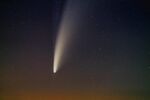Astronomy:2020 CW
| Discovery [1] | |
|---|---|
| Discovered by | MLS |
| Discovery site | Mount Lemon Obs. |
| Discovery date | 1 February 2020 (first observed only) |
| Designations | |
| 2020 CW | |
| Minor planet category | NEO · Apollo [1][2] |
| Orbital characteristics [2] | |
| Epoch 1 February 2020 (JD 2458880.5) | |
| Uncertainty parameter 8[2] · —[1] | |
| Observation arc | 0 day |
| |{{{apsis}}}|helion}} | 1.9980 AU |
| |{{{apsis}}}|helion}} | 0.4769 AU |
| 1.2375 AU | |
| Eccentricity | 0.6146 |
| Orbital period | 1.38 yr (503 d) |
| Mean anomaly | 322.21° |
| Mean motion | 0° 42m 57.6s / day |
| Inclination | 2.1259° |
| Longitude of ascending node | 132.01° |
| 110.66° | |
| Earth MOID | 0.030 LD (0.000076 AU) |
| Physical characteristics | |
| Mean diameter | 1.1 m (est at 0.14)[3][4] |
| Absolute magnitude (H) | 32.5[1][2] 32.6[4] |
2020 CW is a tiny near-Earth asteroid of the Apollo group, approximately 1 meter (3 ft) in diameter. It was first observed by the Mount Lemmon Survey on 1 February 2020,[1] when it passed Earth very closely at a nominal distance of only 0.041 lunar distances (0.000105 astronomical units).[2] The object's orbital elements remain highly uncertain.[1][2]
Description
2020 CW passed within 15,660 kilometres (9,730 mi) of the Earth on 1 February 2020, with a fly-by speed of 21.2 kilometres (13.2 mi) per second.[2] The household-appliance-sized asteroid passed within the orbit of satellites in the geostationary ring at 35,900 kilometres (22,300 mi) above Earth's equator.[5] At the time, it was the closest approach in the year 2020. Since then, 2020 JJ made a closer approach on 4 May 2020.[6]
The asteroid was first observed 1 February 2020 by the Mount Lemmon Survey at Mount Lemmon Observatory in the Santa Catalina Mountains northeast of Tucson, Arizona.[1] The next encounter closer than the Moon is predicted to occur 5 February 2029 at a distance of 19,040 kilometres (11,830 mi) or more.[2]
References
- ↑ 1.0 1.1 1.2 1.3 1.4 1.5 1.6 "2020 CW". Minor Planet Center. https://www.minorplanetcenter.net/db_search/show_object?object_id=2020+CW. Retrieved 5 September 2020.
- ↑ 2.0 2.1 2.2 2.3 2.4 2.5 2.6 2.7 "JPL Small-Body Database Browser: (2020 CW)". Jet Propulsion Laboratory. https://ssd.jpl.nasa.gov/sbdb.cgi?sstr=3989456;cad=1#cad. Retrieved 5 September 2020.
- ↑ "Asteroid Size Estimator". CNEOS NASA/JPL. https://cneos.jpl.nasa.gov/tools/ast_size_est.html. Retrieved 5 September 2020.
- ↑ 4.0 4.1 "ESA space situational awareness 2020CW". European Space Agency. http://neo.ssa.esa.int/search-for-asteroids?tab=summary&des=2020CW.
- ↑ Mack, Eric (4 February 2020). "Adorable asteroid 2020 CW makes one of the closest passes by Earth ever seen". CNET. https://www.cnet.com/news/adorable-asteroid-2020-cw-makes-one-of-the-closest-passes-by-earth-ever-seen/. "It was a harmless flyby for the record books."
- ↑ "NEO Earth Close Approaches". Center for Near Earth Object Studies (CNEOS). https://cneos.jpl.nasa.gov/ca/. "Table Settings: All available data, Nominal dist. <= 1LD, no H limit, sort by CA Distance Nominal"
External links
- List Of Apollo Minor Planets (by designation), Minor Planet Center
- 2020 CW at NeoDyS-2, Near Earth Objects—Dynamic Site
- Ephemeris · Obs prediction · Orbital info · MOID · Proper elements · Obs info · Close · Physical info · NEOCC
- 2020 CW at ESA–space situational awareness
- 2020 CW at the JPL Small-Body Database
 |




